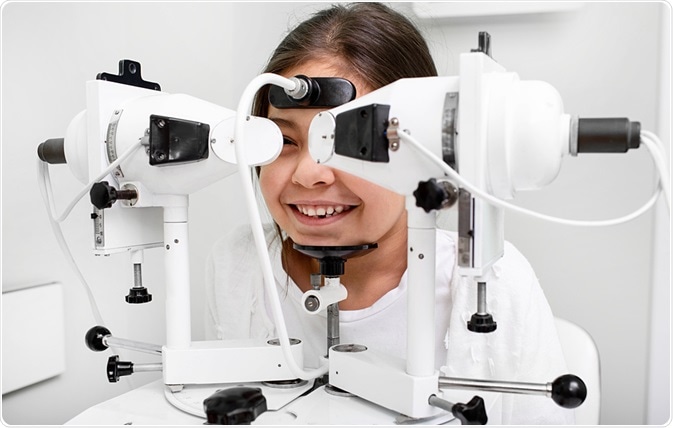An eye exam is usually required to test for and diagnose strabismus, specialized to determine the focus and movement of the eyes, which are the characteristic features of the condition.
Early diagnosis is important because severe cases of strabismus that go untreated can result in loss of vision. For this reason, more young children in developed nations are screened for the condition with an eye examination before the age of 3 years.
 A synoptophore used to diagnose and treat strabismus. Image Credit: Peakstock / Shutterstock.com
A synoptophore used to diagnose and treat strabismus. Image Credit: Peakstock / Shutterstock.com
Medical and symptom history
Prior to performing an eye examination, it is important to obtain a history of the patient, with particular regard to indicative symptoms, environmental factors and related medications or health conditions.
The signs and symptoms indicative of the condition may include:
- Crossed eyes
- Double vision
- Decreased depth perception
- Misaligned eyes with uncoordinated movements
Some health conditions, such as Down syndrome, cerebral palsy and Edwards syndrome are linked to strabismus and patients with these conditions are more likely to experience abnormalities of their eyes.
Eye examination
The eye examination typically consists of several tests that are used to determine the changes in vision as a result of the condition and guide treatment decisions.
It may be conducted without the use of eye drops, as this can help to assess the eyes under everyday working conditions, although they may be needed for patients with poor communication.
The following tests may be a component of the eye examination used to diagnose strabismus:
- Visual acuity test: to assess the changes in vision and clarity of sight at short and long-distance. (e.g. reading letters on a chart at short and long distances)
- Corneal light reflex test: used to determine the extent of refractive error, which is useful in the decision of the lens power needed to compensate for changes. (e.g. using a phoropter and retinoscope to test how different lenses affect vision)
- Alignment and focus test: to assess movement, focus and unity of the eyes.
- Retinal exam: observation of the physical structure of the eye to check for the presence of other diseases of the eye that may be causing the presenting symptoms.
- Cover/uncover test: to measure the deviation and movement of the eyes.
The results of these tests are useful in understanding the presence and severity of the condition, in addition to guiding the choice of treatment.
Misaligned Eyes (Strabismus) and Treatment Explained. What is Strabismus?
Diagnostic classification
There are several types of strabismus according to the direction of the wayward eye that are differentiated in the diagnostic process. These types include:
- Exotropia – eye directed outwards
- Esotropia – eye directed inwards
- Hypertropia – eye directed upwards
- Hypotropia – eye directed downwards
- Cyclotropoia – a combination of other types of eye direction
Additionally, a latent deviation that only presents when binocular vision is disrupted, such as when one eye is covered is identified by changing the end of the classification type. The suffix –phoria is used rather than –tropia and can exist in all directions.
Other testing
Some patients may require further testing to establish the involvement of other related health conditions. For example, a neurological exam is commonly conducted to check for conditions such as cerebral palsy and Guillain-Barre syndrome.
References
Further Reading